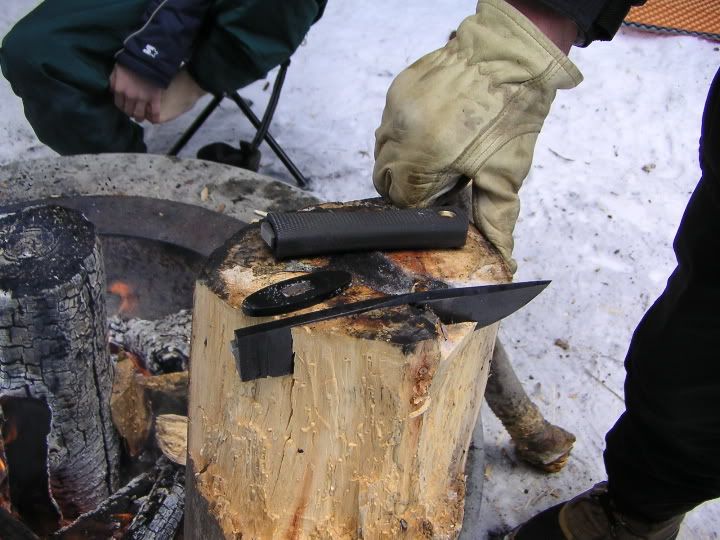- Joined
- Jun 22, 2003
- Messages
- 3,049
i concede that if cold steel is selling their knife under the title combat knife when in reality they mean fighting *there is a very, very distinct difference.* knife, then my argument on what the majority of the people who read the title "combat knife" on their site is somewhat moot.
okay... so...
we know that if you take a knife and make it 3/16" of an inch thick, make it out of a good carbon steel, and heat treat it to around 58rc, it will be a reletively strong knife (fully flat ground). it will not be unbreakable, but it will be able to do a decent amount of heavy use tasks without breaking, including the ocasional hit on a rock, dropped on cement etc.
if you take that knife, and make it 1/4" thick, same design as the previous knife, it will be stronger, because there is more steel supporting it under stress.
if you then make it thicker, to 5/16" thick, it will be stronger still.
by geometry, the knife that is 5/16" is stronger then the same knife at 3/16". this is a very basic peice of structural theory.
however, from what youve said, if a maker says that knife a) that is 3/16 is meant to take very heavy abuse, all you can throw at it, and that knife b) wich is 5/16" is only meant for lighter tasks, and it may break under heavy strain
makes it okay for knife b to break? makes it logical for knife b to break where knife a wouldnt???
it seems like your saying that the makers notion of what his knife should be able to do supersedes what the basic structural design of the knife describes it to be able to do.
seriously, its not possible for the rs to be weaker then the srk unless the rs was intentionally built to be weaker (esentially boobytraps set into the knife to make it fail). the geometry of the rs is twice that of the srk, same steel, same heat treat.
DaQo'tah Forge said:Only the point of view of the maker matters here,,,,If the maker designed a tool to do job "A"....and if the knife breaks doing this job "A"...then the maker knows that the tool failed doing something he aimed for it to be able to do...
However, if the maker created a tool and clearly sold it as a tool that is meant to be able to do "B" types of work,,,,and then finds out that the tool broke while being used to do type- "A" work, (Something he never designed it to do ) then the maker knows that the user abused the tool trying to do a job meant for a different type of tool to do....
okay... so...
we know that if you take a knife and make it 3/16" of an inch thick, make it out of a good carbon steel, and heat treat it to around 58rc, it will be a reletively strong knife (fully flat ground). it will not be unbreakable, but it will be able to do a decent amount of heavy use tasks without breaking, including the ocasional hit on a rock, dropped on cement etc.
if you take that knife, and make it 1/4" thick, same design as the previous knife, it will be stronger, because there is more steel supporting it under stress.
if you then make it thicker, to 5/16" thick, it will be stronger still.
by geometry, the knife that is 5/16" is stronger then the same knife at 3/16". this is a very basic peice of structural theory.
however, from what youve said, if a maker says that knife a) that is 3/16 is meant to take very heavy abuse, all you can throw at it, and that knife b) wich is 5/16" is only meant for lighter tasks, and it may break under heavy strain
makes it okay for knife b to break? makes it logical for knife b to break where knife a wouldnt???
it seems like your saying that the makers notion of what his knife should be able to do supersedes what the basic structural design of the knife describes it to be able to do.
seriously, its not possible for the rs to be weaker then the srk unless the rs was intentionally built to be weaker (esentially boobytraps set into the knife to make it fail). the geometry of the rs is twice that of the srk, same steel, same heat treat.

